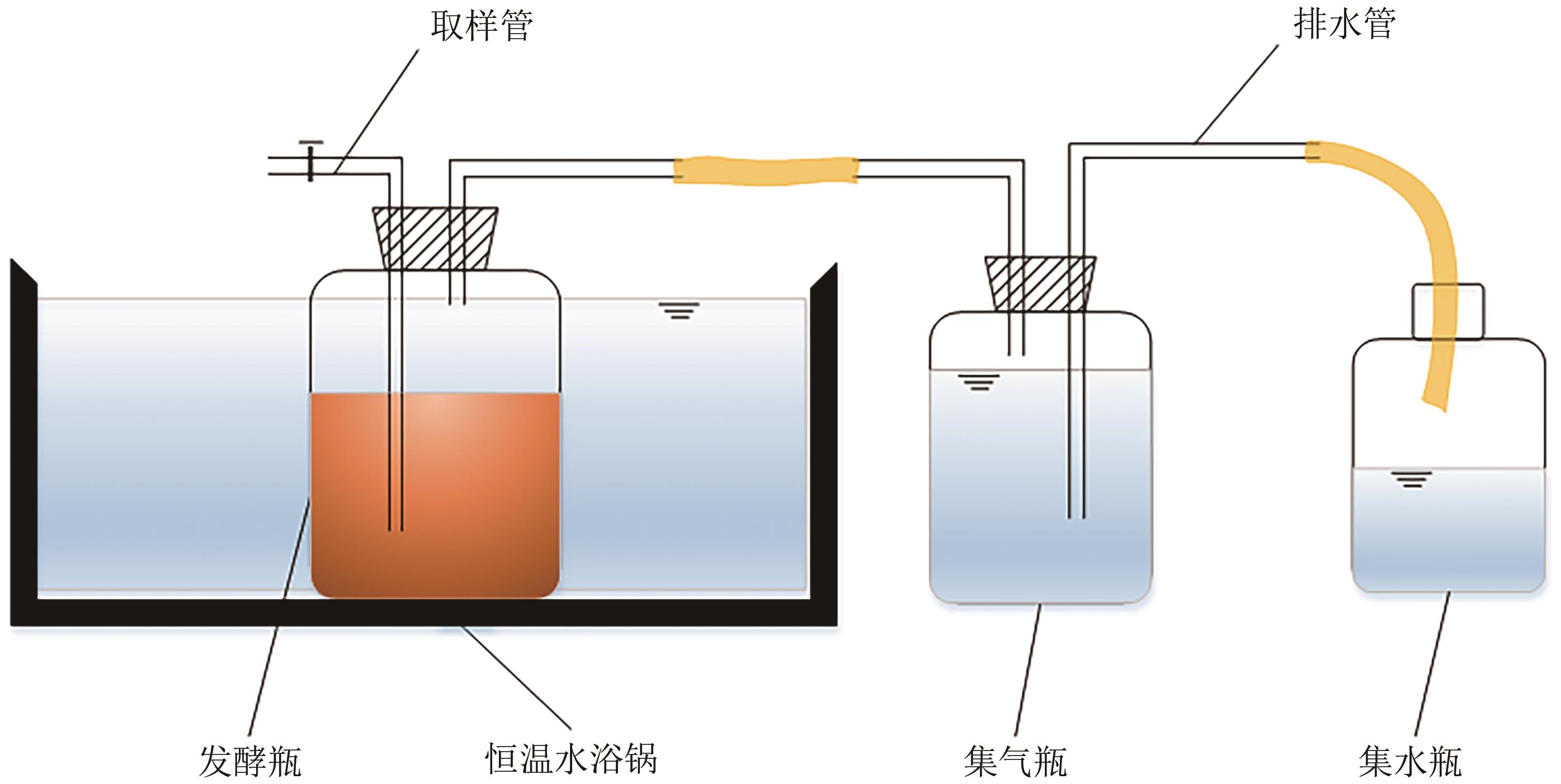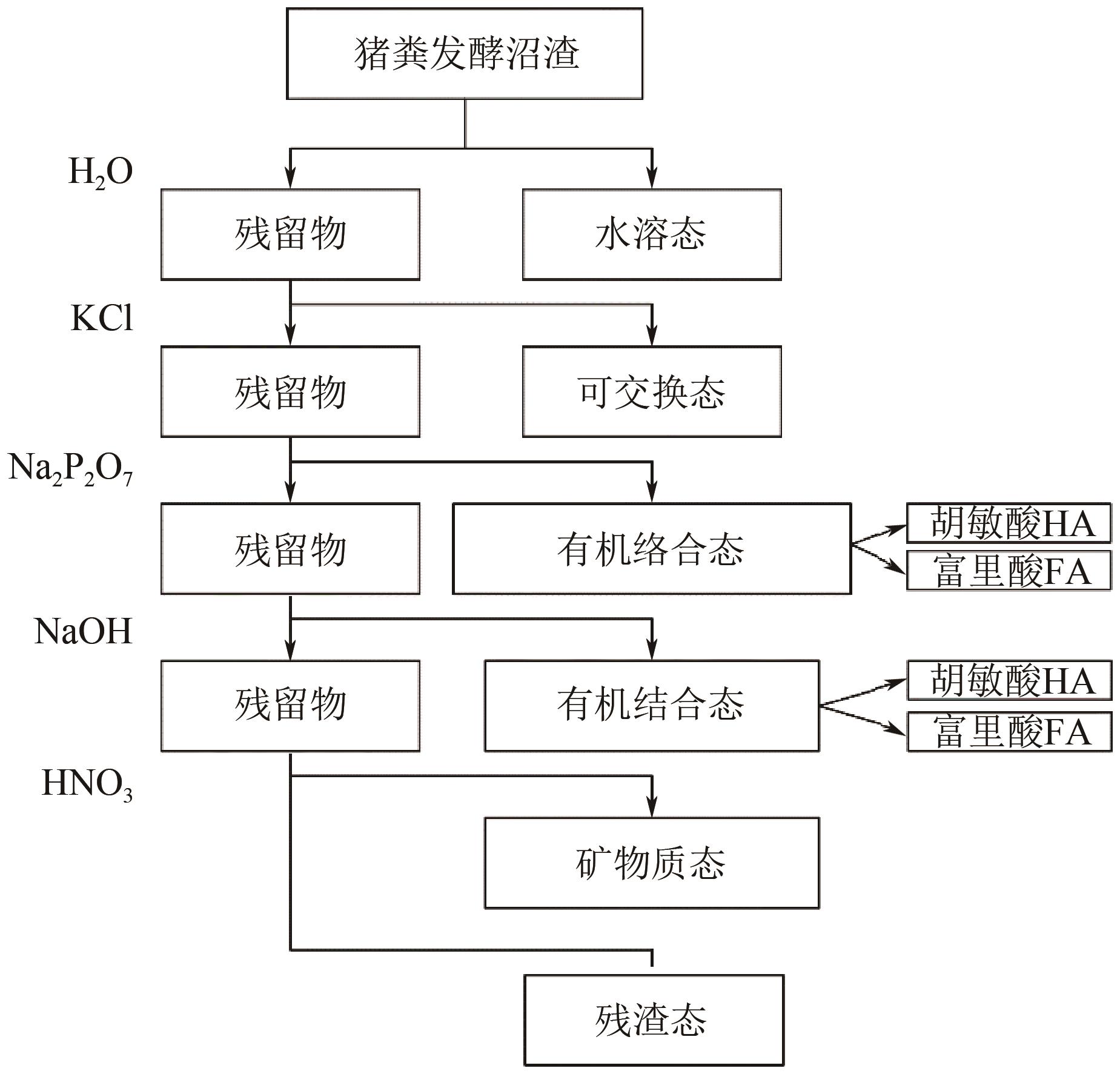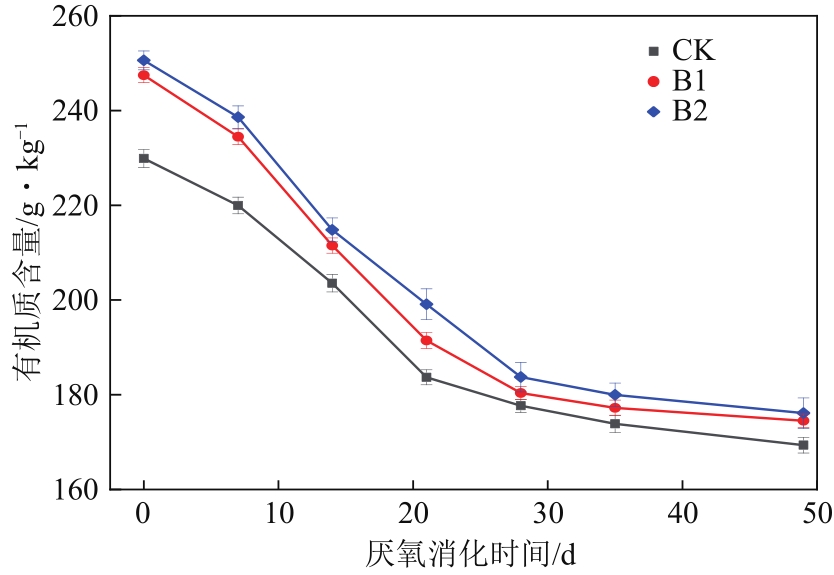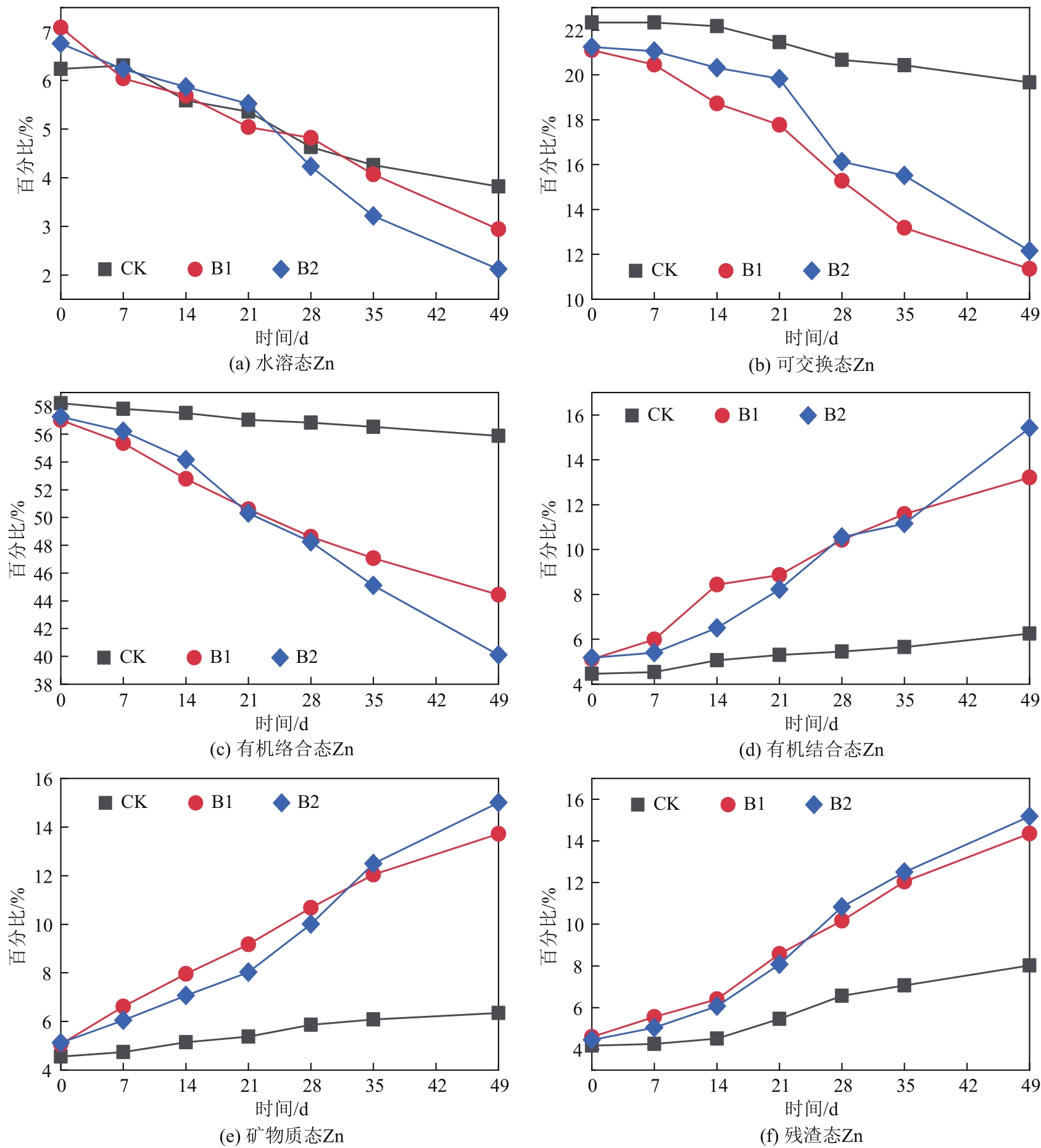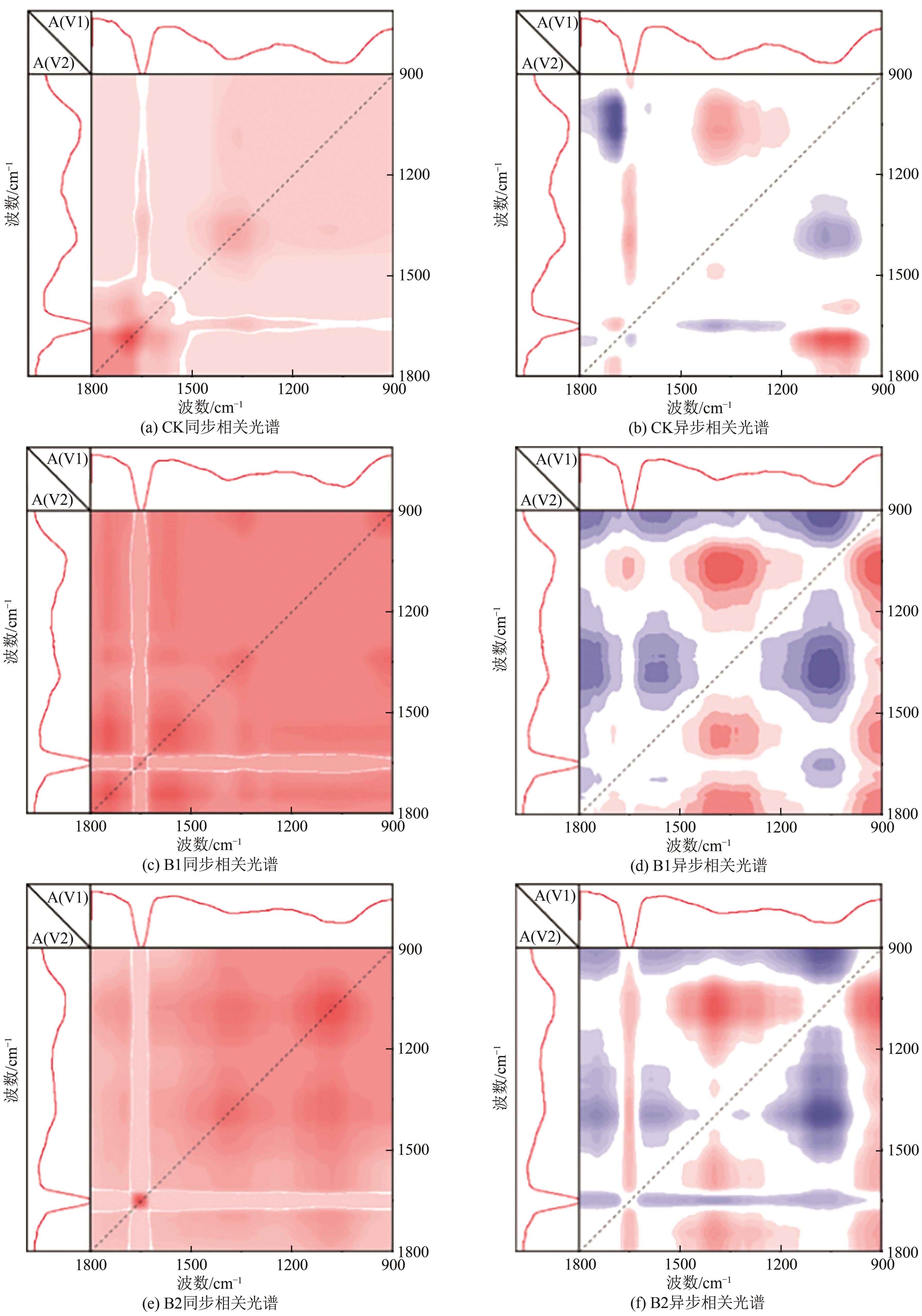Chemical Industry and Engineering Progress ›› 2023, Vol. 42 ›› Issue (6): 3281-3291.DOI: 10.16085/j.issn.1000-6613.2022-1519
• Resources and environmental engineering • Previous Articles Next Articles
Organic binding mechanism of heavy metals and humus during anaerobic digestion of pig manure
ZHUANG Jie( ), XUE Jinhui, ZHAO Bincheng, ZHANG Wenyi(
), XUE Jinhui, ZHAO Bincheng, ZHANG Wenyi( )
)
- School of Environmental Science and Engineering, Changzhou University, Changzhou 213164, Jiangsu, China
-
Received:2022-08-17Revised:2022-10-04Online:2023-06-29Published:2023-06-25 -
Contact:ZHANG Wenyi
猪粪厌氧消化进程中重金属与腐殖质的有机结合机制
- 常州大学环境科学与工程学院,江苏 常州 213164
-
通讯作者:张文艺 -
作者简介:庄捷(1998—),男,硕士研究生,研究方向为固体废弃物污染控制。E-mail:375834214@qq.com。 -
基金资助:江苏省科技支撑计划(BE2020761);2021年江苏省研究生科研与实践创新计划(SJCX21-0942)
CLC Number:
Cite this article
ZHUANG Jie, XUE Jinhui, ZHAO Bincheng, ZHANG Wenyi. Organic binding mechanism of heavy metals and humus during anaerobic digestion of pig manure[J]. Chemical Industry and Engineering Progress, 2023, 42(6): 3281-3291.
庄捷, 薛锦辉, 赵斌成, 张文艺. 猪粪厌氧消化进程中重金属与腐殖质的有机结合机制[J]. 化工进展, 2023, 42(6): 3281-3291.
share this article
Add to citation manager EndNote|Ris|BibTeX
URL: https://hgjz.cip.com.cn/EN/10.16085/j.issn.1000-6613.2022-1519
| 材料 | 含水率/% | 总有机碳含量/% | 总氮含量/% | C/N |
|---|---|---|---|---|
| 猪粪 | 79.84 | 9.20 | 0.59 | 15.59 |
| 玉米秸秆 | 4.45 | 15.13 | 0.36 | 42.03 |
| 材料 | 含水率/% | 总有机碳含量/% | 总氮含量/% | C/N |
|---|---|---|---|---|
| 猪粪 | 79.84 | 9.20 | 0.59 | 15.59 |
| 玉米秸秆 | 4.45 | 15.13 | 0.36 | 42.03 |
| 材料 | 铜含量/mg·kg-1 | 锌含量/mg·kg-1 |
|---|---|---|
| 猪粪 | 254.17 | 1039.83 |
| 玉米秸秆 | ND | ND |
| 腐殖酸 | 14.20 | 64.33 |
| 粉煤灰 | 71.24 | 118.46 |
| 生物炭 | 6.56 | 59.85 |
| 材料 | 铜含量/mg·kg-1 | 锌含量/mg·kg-1 |
|---|---|---|
| 猪粪 | 254.17 | 1039.83 |
| 玉米秸秆 | ND | ND |
| 腐殖酸 | 14.20 | 64.33 |
| 粉煤灰 | 71.24 | 118.46 |
| 生物炭 | 6.56 | 59.85 |
| 水平 | 腐殖酸/% | 粉煤灰/% | 生物炭/% |
|---|---|---|---|
| 1 | 2.5 | 2.5 | 2.5 |
| 2 | 5.0 | 5.0 | 5.0 |
| 3 | 7.5 | 7.5 | 7.5 |
| 水平 | 腐殖酸/% | 粉煤灰/% | 生物炭/% |
|---|---|---|---|
| 1 | 2.5 | 2.5 | 2.5 |
| 2 | 5.0 | 5.0 | 5.0 |
| 3 | 7.5 | 7.5 | 7.5 |
| 编号 | 因素 | 钝化效果 | ||||
|---|---|---|---|---|---|---|
| A | B | C | 空列 | Cu钝化率/% | Zn钝化率/% | |
| S1 | 1 | 1 | 1 | 1 | 43.92 | 23.87 |
| S2 | 2 | 1 | 2 | 2 | 56.96 | 26.85 |
| S3 | 3 | 1 | 3 | 3 | 70.02 | 28.02 |
| S4 | 1 | 2 | 2 | 3 | 49.77 | 26.11 |
| S5 | 2 | 2 | 3 | 1 | 65.17 | 36.24 |
| S6 | 3 | 2 | 1 | 2 | 61.10 | 34.29 |
| S7 | 1 | 3 | 3 | 2 | 54.92 | 35.03 |
| S8 | 2 | 3 | 1 | 3 | 62.11 | 38.30 |
| S9 | 3 | 3 | 2 | 1 | 63.18 | 34.04 |
| Cu钝化极差分析 | ||||||
| K1 | 49.54 | 56.97 | 55.71 | 57.42 | 主次因素 | A>C>B |
| K2 | 61.41 | 58.68 | 56.64 | 57.66 | ||
| K3 | 64.76 | 60.07 | 63.37 | 60.63 | 最优方案 | A3B3C3 |
| R | 15.23 | 3.10 | 7.66 | 3.21 | ||
| Zn钝化极差分析 | ||||||
| K1 | 28.34 | 26.25 | 32.15 | 31.38 | 主次因素 | B>A>C |
| K2 | 33.80 | 32.21 | 29.00 | 32.06 | ||
| K3 | 32.12 | 35.79 | 33.10 | 30.81 | 最优方案 | A2B3C3 |
| R | 5.46 | 9.54 | 4.10 | 1.25 | ||
| 编号 | 因素 | 钝化效果 | ||||
|---|---|---|---|---|---|---|
| A | B | C | 空列 | Cu钝化率/% | Zn钝化率/% | |
| S1 | 1 | 1 | 1 | 1 | 43.92 | 23.87 |
| S2 | 2 | 1 | 2 | 2 | 56.96 | 26.85 |
| S3 | 3 | 1 | 3 | 3 | 70.02 | 28.02 |
| S4 | 1 | 2 | 2 | 3 | 49.77 | 26.11 |
| S5 | 2 | 2 | 3 | 1 | 65.17 | 36.24 |
| S6 | 3 | 2 | 1 | 2 | 61.10 | 34.29 |
| S7 | 1 | 3 | 3 | 2 | 54.92 | 35.03 |
| S8 | 2 | 3 | 1 | 3 | 62.11 | 38.30 |
| S9 | 3 | 3 | 2 | 1 | 63.18 | 34.04 |
| Cu钝化极差分析 | ||||||
| K1 | 49.54 | 56.97 | 55.71 | 57.42 | 主次因素 | A>C>B |
| K2 | 61.41 | 58.68 | 56.64 | 57.66 | ||
| K3 | 64.76 | 60.07 | 63.37 | 60.63 | 最优方案 | A3B3C3 |
| R | 15.23 | 3.10 | 7.66 | 3.21 | ||
| Zn钝化极差分析 | ||||||
| K1 | 28.34 | 26.25 | 32.15 | 31.38 | 主次因素 | B>A>C |
| K2 | 33.80 | 32.21 | 29.00 | 32.06 | ||
| K3 | 32.12 | 35.79 | 33.10 | 30.81 | 最优方案 | A2B3C3 |
| R | 5.46 | 9.54 | 4.10 | 1.25 | ||
| 处理 | 时间/d | Na4P2O7 | NaOH | 总HA/FA | ||||
|---|---|---|---|---|---|---|---|---|
| HA | FA | HA/FA | HA | FA | HA/FA | |||
| CK | 0 | 53.57 | 46.43 | 1.15 | 52.63 | 47.37 | 1.11 | 1.13 |
| 7 | 58.82 | 41.18 | 1.43 | 56.25 | 43.75 | 1.29 | 1.36 | |
| 14 | 68.00 | 32.00 | 2.13 | 58.82 | 41.18 | 1.43 | 1.78 | |
| 21 | 70.83 | 29.17 | 2.43 | 60.00 | 40.00 | 1.50 | 1.96 | |
| 28 | 75.00 | 25.00 | 3.00 | 65.22 | 34.78 | 1.88 | 2.44 | |
| 35 | 76.92 | 23.08 | 3.33 | 63.64 | 36.36 | 1.75 | 2.54 | |
| 49 | 78.57 | 21.43 | 3.67 | 68.29 | 31.71 | 2.15 | 2.91 | |
| B1 | 0 | 56.67 | 43.33 | 1.31 | 54.84 | 45.16 | 1.21 | 1.26 |
| 7 | 60.42 | 39.58 | 1.53 | 59.18 | 40.82 | 1.45 | 1.49 | |
| 14 | 60.87 | 39.13 | 1.56 | 62.50 | 37.50 | 1.67 | 1.61 | |
| 21 | 68.18 | 31.82 | 2.14 | 64.71 | 35.29 | 1.83 | 1.99 | |
| 28 | 78.13 | 21.88 | 3.57 | 64.29 | 35.71 | 1.80 | 2.69 | |
| 35 | 80.88 | 19.12 | 4.23 | 67.35 | 32.65 | 2.06 | 3.15 | |
| 49 | 85.42 | 14.58 | 5.86 | 69.23 | 30.77 | 2.25 | 4.05 | |
| B2 | 0 | 57.89 | 42.11 | 1.38 | 54.05 | 45.95 | 1.18 | 1.28 |
| 7 | 61.90 | 38.10 | 1.63 | 60.00 | 40.00 | 1.50 | 1.56 | |
| 14 | 70.00 | 30.00 | 2.33 | 63.27 | 36.73 | 1.72 | 2.03 | |
| 21 | 74.07 | 25.93 | 2.86 | 63.64 | 36.36 | 1.75 | 2.30 | |
| 28 | 77.50 | 22.50 | 3.44 | 65.00 | 35.00 | 1.86 | 2.65 | |
| 35 | 80.36 | 19.64 | 4.09 | 67.92 | 32.08 | 2.12 | 3.10 | |
| 49 | 85.71 | 14.29 | 6.00 | 69.44 | 30.56 | 2.27 | 4.14 | |
| 处理 | 时间/d | Na4P2O7 | NaOH | 总HA/FA | ||||
|---|---|---|---|---|---|---|---|---|
| HA | FA | HA/FA | HA | FA | HA/FA | |||
| CK | 0 | 53.57 | 46.43 | 1.15 | 52.63 | 47.37 | 1.11 | 1.13 |
| 7 | 58.82 | 41.18 | 1.43 | 56.25 | 43.75 | 1.29 | 1.36 | |
| 14 | 68.00 | 32.00 | 2.13 | 58.82 | 41.18 | 1.43 | 1.78 | |
| 21 | 70.83 | 29.17 | 2.43 | 60.00 | 40.00 | 1.50 | 1.96 | |
| 28 | 75.00 | 25.00 | 3.00 | 65.22 | 34.78 | 1.88 | 2.44 | |
| 35 | 76.92 | 23.08 | 3.33 | 63.64 | 36.36 | 1.75 | 2.54 | |
| 49 | 78.57 | 21.43 | 3.67 | 68.29 | 31.71 | 2.15 | 2.91 | |
| B1 | 0 | 56.67 | 43.33 | 1.31 | 54.84 | 45.16 | 1.21 | 1.26 |
| 7 | 60.42 | 39.58 | 1.53 | 59.18 | 40.82 | 1.45 | 1.49 | |
| 14 | 60.87 | 39.13 | 1.56 | 62.50 | 37.50 | 1.67 | 1.61 | |
| 21 | 68.18 | 31.82 | 2.14 | 64.71 | 35.29 | 1.83 | 1.99 | |
| 28 | 78.13 | 21.88 | 3.57 | 64.29 | 35.71 | 1.80 | 2.69 | |
| 35 | 80.88 | 19.12 | 4.23 | 67.35 | 32.65 | 2.06 | 3.15 | |
| 49 | 85.42 | 14.58 | 5.86 | 69.23 | 30.77 | 2.25 | 4.05 | |
| B2 | 0 | 57.89 | 42.11 | 1.38 | 54.05 | 45.95 | 1.18 | 1.28 |
| 7 | 61.90 | 38.10 | 1.63 | 60.00 | 40.00 | 1.50 | 1.56 | |
| 14 | 70.00 | 30.00 | 2.33 | 63.27 | 36.73 | 1.72 | 2.03 | |
| 21 | 74.07 | 25.93 | 2.86 | 63.64 | 36.36 | 1.75 | 2.30 | |
| 28 | 77.50 | 22.50 | 3.44 | 65.00 | 35.00 | 1.86 | 2.65 | |
| 35 | 80.36 | 19.64 | 4.09 | 67.92 | 32.08 | 2.12 | 3.10 | |
| 49 | 85.71 | 14.29 | 6.00 | 69.44 | 30.56 | 2.27 | 4.14 | |
| 处理 | 时间/d | Na4P2O7 | NaOH | ||
|---|---|---|---|---|---|
| HA | FA | HA | FA | ||
| CK | 0 | 4.45 | 95.55 | 2.30 | 97.70 |
| 7 | 5.12 | 94.88 | 4.77 | 95.23 | |
| 14 | 8.61 | 91.39 | 6.33 | 93.67 | |
| 21 | 11.85 | 88.15 | 9.62 | 90.38 | |
| 28 | 15.63 | 84.37 | 12.69 | 87.31 | |
| 35 | 16.53 | 83.47 | 13.29 | 86.71 | |
| 49 | 18.26 | 81.74 | 15.82 | 84.18 | |
| B1 | 0 | 5.15 | 94.85 | 4.17 | 95.83 |
| 7 | 8.60 | 91.40 | 7.98 | 92.02 | |
| 14 | 12.94 | 87.06 | 11.23 | 88.77 | |
| 21 | 17.98 | 82.02 | 17.38 | 82.62 | |
| 28 | 23.69 | 76.31 | 23.51 | 76.49 | |
| 35 | 27.90 | 72.10 | 26.65 | 73.35 | |
| 49 | 31.69 | 68.31 | 30.38 | 69.62 | |
| B2 | 0 | 5.79 | 94.21 | 3.80 | 96.20 |
| 7 | 7.88 | 92.12 | 6.82 | 93.18 | |
| 14 | 10.29 | 89.71 | 9.03 | 90.97 | |
| 21 | 15.38 | 84.62 | 12.01 | 87.99 | |
| 28 | 18.41 | 81.59 | 17.71 | 82.29 | |
| 35 | 23.24 | 76.76 | 21.13 | 78.87 | |
| 49 | 27.91 | 72.09 | 25.03 | 74.97 | |
| 处理 | 时间/d | Na4P2O7 | NaOH | ||
|---|---|---|---|---|---|
| HA | FA | HA | FA | ||
| CK | 0 | 4.45 | 95.55 | 2.30 | 97.70 |
| 7 | 5.12 | 94.88 | 4.77 | 95.23 | |
| 14 | 8.61 | 91.39 | 6.33 | 93.67 | |
| 21 | 11.85 | 88.15 | 9.62 | 90.38 | |
| 28 | 15.63 | 84.37 | 12.69 | 87.31 | |
| 35 | 16.53 | 83.47 | 13.29 | 86.71 | |
| 49 | 18.26 | 81.74 | 15.82 | 84.18 | |
| B1 | 0 | 5.15 | 94.85 | 4.17 | 95.83 |
| 7 | 8.60 | 91.40 | 7.98 | 92.02 | |
| 14 | 12.94 | 87.06 | 11.23 | 88.77 | |
| 21 | 17.98 | 82.02 | 17.38 | 82.62 | |
| 28 | 23.69 | 76.31 | 23.51 | 76.49 | |
| 35 | 27.90 | 72.10 | 26.65 | 73.35 | |
| 49 | 31.69 | 68.31 | 30.38 | 69.62 | |
| B2 | 0 | 5.79 | 94.21 | 3.80 | 96.20 |
| 7 | 7.88 | 92.12 | 6.82 | 93.18 | |
| 14 | 10.29 | 89.71 | 9.03 | 90.97 | |
| 21 | 15.38 | 84.62 | 12.01 | 87.99 | |
| 28 | 18.41 | 81.59 | 17.71 | 82.29 | |
| 35 | 23.24 | 76.76 | 21.13 | 78.87 | |
| 49 | 27.91 | 72.09 | 25.03 | 74.97 | |
| 处理 | 时间/d | Na4P2O7 | NaOH | ||
|---|---|---|---|---|---|
| HA | FA | HA | FA | ||
| CK | 0 | 4.42 | 95.58 | 4.47 | 95.53 |
| 7 | 5.82 | 94.18 | 4.99 | 95.01 | |
| 14 | 5.56 | 94.44 | 5.64 | 94.36 | |
| 21 | 6.83 | 93.17 | 6.37 | 93.63 | |
| 28 | 8.59 | 91.41 | 7.44 | 92.56 | |
| 35 | 9.37 | 90.63 | 8.13 | 91.87 | |
| 49 | 10.61 | 89.39 | 10.46 | 89.54 | |
| B1 | 0 | 4.17 | 95.83 | 4.52 | 95.48 |
| 7 | 5.40 | 94.60 | 5.91 | 94.09 | |
| 14 | 6.54 | 93.46 | 6.63 | 93.37 | |
| 21 | 6.91 | 93.09 | 7.79 | 92.21 | |
| 28 | 9.40 | 90.60 | 10.42 | 89.58 | |
| 35 | 11.94 | 88.06 | 11.05 | 88.95 | |
| 49 | 13.03 | 86.97 | 13.40 | 86.60 | |
| B2 | 0 | 4.66 | 95.34 | 4.86 | 95.14 |
| 7 | 5.87 | 94.13 | 6.31 | 93.69 | |
| 14 | 6.05 | 93.95 | 7.90 | 92.10 | |
| 21 | 8.47 | 91.53 | 9.47 | 90.53 | |
| 28 | 11.06 | 88.94 | 12.96 | 87.04 | |
| 35 | 13.98 | 86.02 | 14.87 | 85.13 | |
| 49 | 16.27 | 83.73 | 17.64 | 82.36 | |
| 处理 | 时间/d | Na4P2O7 | NaOH | ||
|---|---|---|---|---|---|
| HA | FA | HA | FA | ||
| CK | 0 | 4.42 | 95.58 | 4.47 | 95.53 |
| 7 | 5.82 | 94.18 | 4.99 | 95.01 | |
| 14 | 5.56 | 94.44 | 5.64 | 94.36 | |
| 21 | 6.83 | 93.17 | 6.37 | 93.63 | |
| 28 | 8.59 | 91.41 | 7.44 | 92.56 | |
| 35 | 9.37 | 90.63 | 8.13 | 91.87 | |
| 49 | 10.61 | 89.39 | 10.46 | 89.54 | |
| B1 | 0 | 4.17 | 95.83 | 4.52 | 95.48 |
| 7 | 5.40 | 94.60 | 5.91 | 94.09 | |
| 14 | 6.54 | 93.46 | 6.63 | 93.37 | |
| 21 | 6.91 | 93.09 | 7.79 | 92.21 | |
| 28 | 9.40 | 90.60 | 10.42 | 89.58 | |
| 35 | 11.94 | 88.06 | 11.05 | 88.95 | |
| 49 | 13.03 | 86.97 | 13.40 | 86.60 | |
| B2 | 0 | 4.66 | 95.34 | 4.86 | 95.14 |
| 7 | 5.87 | 94.13 | 6.31 | 93.69 | |
| 14 | 6.05 | 93.95 | 7.90 | 92.10 | |
| 21 | 8.47 | 91.53 | 9.47 | 90.53 | |
| 28 | 11.06 | 88.94 | 12.96 | 87.04 | |
| 35 | 13.98 | 86.02 | 14.87 | 85.13 | |
| 49 | 16.27 | 83.73 | 17.64 | 82.36 | |
| 1 | JAISWAL A, VERMA A, JAISWAL P. Detrimental effects of heavy metals in soil, plants, and aquatic ecosystems and in humans[J]. Journal of Environmental Pathology, Toxicology and Oncology, 2018, 37(3): 183-197. |
| 2 | LIU Wangrong, ZENG Dong, SHE Lei, et al. Comparisons of pollution characteristics, emission situations, and mass loads for heavy metals in the manures of different livestock and poultry in China[J]. The Science of the Total Environment, 2020, 734: 139023. |
| 3 | 李轶, 刘艳杰, 冯洋洋, 等. 沸石对猪粪沼气发酵特性及沼渣、沼液中重金属Zn的影响[J]. 可再生能源, 2016, 34(6): 943-948. |
| LI Yi, LIU Yanjie, FENG Yangyang, et al. Effects of adding zeolite on pig manure anaerobic fermentation and the change of heavy metal Zinc in digestate[J]. Renewable Energy Resources, 2016, 34(6): 943-948. | |
| 4 | 安登飞. 土壤重金属活化和钝化技术研究进展[J]. 中国资源综合利用, 2021, 39(11): 93-95. |
| AN Dengfei. Research progress on activation and passivation technology of heavy metals in soil[J]. China Resources Comprehensive Utilization, 2021, 39(11): 93-95, 104. | |
| 5 | 蔡旭影. 农田土壤重金属As、Cd污染的钝化剂修复效果及风险评价[D]. 北京: 北京交通大学, 2021. |
| CAI Xuying. Evaluation of remediation effect and risk of heavy metal As and Cd contamination in agricultural soils by passivation agents[D]. Beijing: Beijing Jiaotong University, 2021. | |
| 6 | 曾心雨, 赵欢, 李玉成, 等. Fe2O3对猪粪厌氧发酵及沼渣中Cu、As的钝化效果[J]. 江苏农业科学, 2020, 48(6): 260-264. |
| ZENG Xinyu, ZHAO Huan, LI Yucheng, et al. Effect of Fe2O3 on anaerobic fermentation of pig manure and passivation of Cu and As in biogas dregs[J]. Jiangsu Agricultural Sciences, 2020, 48(6): 260-264. | |
| 7 | 冯晶, 荆勇, 赵立欣, 等. 生物炭强化有机废弃物厌氧发酵技术研究[J]. 农业工程学报, 2019, 35(12): 256-264. |
| FENG Jing, JING Yong, ZHAO Lixin, et al. Research progress on biochar enhanced anaerobic fermentation technology of organic wastes[J]. Transactions of the Chinese Society of Agricultural Engineering, 2019, 35(12): 256-264. | |
| 8 | 周坤渊, 刘仕翔, 罗泽娇. 常见碱性工业废渣稳定化修复重金属污染土壤的研究进展[J]. 安全与环境工程, 2021, 28(6): 174-181. |
| ZHOU Kunyuan, LIU Shixiang, LUO Zejiao. Research progress on stabilization of heavy metals in soil by common alkaline industrial wastes[J].Safety and Environmental Engineering, 2021, 28(6): 174-181. | |
| 9 | HE En, Changwei LYU, HE Jiang, et al. Binding characteristics of Cu2+ to natural humic acid fractions sequentially extracted from the lake sediments[J]. Environmental Science and Pollution Research, 2016, 23(22): 22667-22677. |
| 10 | 何丽霞, 张丰松, 张桂香, 等. 复配钝化剂对稻田重金属有效性及其水稻吸收的影响[J]. 环境工程学报, 2022, 16(2): 565-575. |
| HE Lixia, ZHANG Fengsong, ZHANG Guixiang, et al. Effects of combined passivators on the availability of heavy metals in red paddy soil and their uptake by rice[J]. Chinese Journal of Environmental Engineering, 2022, 16(2): 565-575. | |
| 11 | WANG Xiqing, Tao LYU, DONG Renjie, et al. Dynamic evolution of humic acids during anaerobic digestion: Exploring an effective auxiliary agent for heavy metal remediation[J]. Bioresource Technology, 2021, 320(Pt A): 124331 |
| 12 | HE X T, LOGAN T J, TRAINA S J. Physical and chemical characteristics of selected US municipal solid waste composts[J]. Journal of Environmental Quality, 1995: 543-552. |
| 13 | 巩俊璐, 钝化剂对猪粪/秸秆厌氧消化中铜和锌减害化的影响研究[D]. 沈阳: 沈阳农业大学, 2018. |
| GONG Junlu. Effect of passivating agent on the reduction of Cu and Zn in anaerobic fermentation of pig manure/straw[D]. Shenyang: Shenyang Agricultural University, 2018. | |
| 14 | 王立闯, 郝娇, 李延吉, 等. 玉米秸秆对鸡粪厌氧发酵过程及酶活性的影响规律研究[J]. 可再生能源, 2021, 39(11): 1441-1446. |
| WANG Lichuang, HAO Jiao, LI Yanji, et al. Study on the effect of corn straw on the chicken manure anaerobic digestion process and the change of enzyme activity[J]. Renewable Energy Resources, 2021, 39(11): 1441-1446. | |
| 15 | 李轶, 曲壮壮, 巩俊璐, 等. 海泡石对猪粪秸秆厌氧发酵产物中Cd的钝化效果研究[J]. 农业工程学报, 2018, 34(S1): 1-6. |
| LI Yi, QU Zhuangzhuang, GONG Junlu, et al. Passivation effect of Cd by sepiolite in anaerobic fermentation products with pig manure and straw[J]. Transactions of the Chinese Society of Agricultural Engineering, 2018, 34(S1): 1-6. | |
| 16 | 李轶, 宫兴隆, 郭敬阳, 等. 不同预处理玉米秸秆对猪粪厌氧发酵重金属镉钝化效果[J]. 农业工程学报, 2020, 36(11): 254-260. |
| LI Yi, GONG Xinglong, GUO Jingyang, et al. Effects of various pretreated maize stovers on the passivation of cadmium by anaerobic fermentation of pig manure[J]. Transactions of the Chinese Society of Agricultural Engineering, 2020, 36(11): 254-260. | |
| 17 | 许剑敏, 郭锋, 刘子姣, 等. 不同钝化剂对猪粪菌渣堆肥中Cu、Zn钝化的影响[J]. 山西农业科学, 2019, 47(12): 2155-2158. |
| XU Jianmin, GUO Feng, LIU Zijiao, et al. Effect of different passivation on heavy metals Cu, Zn during composting of pig manure and mushroom[J]. Journal of Shanxi Agricultural Sciences, 2019, 47(12): 2155-2158. | |
| 18 | 黄国锋, 张振钿, 钟流举, 等. 重金属在猪粪堆肥过程中的化学变化[J]. 中国环境科学, 2004, 24(1): 94-99. |
| HUANG Guofeng, ZHANG Zhentian, ZHONG Liuju, et al. Chemical changes of heavy metals in the process of pig manure composting[J]. China Environmental Science, 2004, 24(1): 94-99. | |
| 19 | LU Duian, WANG Lixia, YAN Baixing, et al. Speciation of Cu and Zn during composting of pig manure amended with rock phosphate[J]. Waste Management, 2014, 34(8): 1529-1536. |
| 20 | 张雪英, 周顺桂, 周立祥, 等. 堆肥处理对污泥腐殖物质形态及其重金属分配的影响[J]. 生态学杂志, 2004, 23(1): 30-33. |
| ZHANG Xueying, ZHOU Shungui, ZHOU Lixiang, et al. Component changes of humic substances and heavy metal distribution before and after sewage sludge composting[J]. Chinese Journal of Ecology, 2004, 23(1): 30-33. | |
| 21 | LIU Hongtao, WANG Lixia, ZHONG Rongzhen, et al. Binding characteristics of humic substances with Cu and Zn in response to inorganic mineral additives during swine manure composting[J]. Journal of Environmental Management, 2022, 305: 114387. |
| 22 | 孙向平, 李国学, 肖爱平, 等. 添加不同比例玉米秸秆对猪粪高温堆肥过程中胡敏酸的结构组成及红外光谱特性影响分析[J]. 光谱学与光谱分析, 2014, 34(9): 2413-2418. |
| SUN Xiangping, LI Guoxue, XIAO Aiping, et al. Analysis on the impact of composting with different proportions of corn stalks and pig manure on humic acid fractions and IR spectral feature[J]. Spectroscopy and Spectral Analysis, 2014, 34(9): 2413-2418. | |
| 23 | 栾润宇, 徐应明, 高珊, 等. 不同发酵方式对鸡粪重金属及有机质影响[J]. 中国环境科学, 2020, 40(8): 3486-3494. |
| LUAN Runyu, XU Yingming, GAO Shan, et al. Heavy metal and organic matters in the chicken manure under different types of composting[J]. China Environmental Science, 2020, 40(8): 3486-3494. | |
| 24 | NODA I. Two-dimensional correlation spectroscopy: applications in vibrational and optical spectroscopy[M]. London: John Wiley and Sons Inc., 2004: 36. |
| [1] | XI Yonglan, WANG Chengcheng, YE Xiaomei, LIU Yang, JIA Zhaoyan, CAO Chunhui, HAN Ting, ZHANG Yingpeng, TIAN Yu. Research progress on the application of micro/nano bubbles in anaerobic digestion [J]. Chemical Industry and Engineering Progress, 2023, 42(8): 4414-4423. |
| [2] | LIU Yang, YE Xiaomei, MIAO Xiao, WANG Chengcheng, JIA Zhaoyan, CAO Chunhui, XI Yonglan. Pilot-scale process research on dry digestion of rural organic household waste under ammonia stress [J]. Chemical Industry and Engineering Progress, 2023, 42(7): 3847-3854. |
| [3] | MENG Xiaoshan, TANG Zijian, CHEN Lin, HUHE Taoli, ZHOU Zhengzhong. Research progress of the early warning and regulation techniques for excessive acidification in the anaerobic digestion system [J]. Chemical Industry and Engineering Progress, 2023, 42(3): 1595-1605. |
| [4] | ZHU Jiaxin, ZHU Wenzhe, XU Jun, XIE Jing, WANG Wenbiao, XIE Li. Enhancement of anaerobic digestion under antibiotics stress via conductive materials application: A review [J]. Chemical Industry and Engineering Progress, 2023, 42(2): 1008-1019. |
| [5] | LIU Yali, ZHANG Hongwei, KANG Xiaorong. Effect and mechanisms of microplastics on anaerobic digestion of sludge [J]. Chemical Industry and Engineering Progress, 2022, 41(9): 5037-5046. |
| [6] | LIU Yang, YE Xiaomei, WANG Chengcheng, JIA Zhaoyan, DU Jing, KONG Xiangping, XI Yonglan. Optimization of anaerobic co-digestion process of rural organic household waste with other substrates [J]. Chemical Industry and Engineering Progress, 2022, 41(5): 2770-2777. |
| [7] | SHAO Mingshuai, ZHANG Chao, WU Huanan, WANG Ning, CHEN Qindong, XU Qiyong. Treatment process and energy analysis of hydrothermal treatment coupled with anaerobic digestion on food waste digestate management [J]. Chemical Industry and Engineering Progress, 2022, 41(5): 2733-2742. |
| [8] | ZHENG Xiaomei, LIN Rujing, ZHOU Wenjing, XU Ling, ZHANG Hongning, ZHANG Xinying, XIE Li. Review on cathode materials for CO2 methanation assisted by microbial electrolytic cell [J]. Chemical Industry and Engineering Progress, 2022, 41(5): 2476-2486. |
| [9] | RUAN Min, SUN Yutong, HUANG Zhongliang, LI Hui, ZHANG Xuan, WU Xikai, ZHAO Cheng, YAO Shirong, ZHANG Shuanbao, ZHANG Wei, HUANG Jing. Energy economy evaluation of sludge pretreatment-anaerobic digestion system [J]. Chemical Industry and Engineering Progress, 2022, 41(3): 1503-1516. |
| [10] | JIANG Ruqing, YU Guangwei, WANG Yu, LI Changjiang, XING Zhenjiao. Preparation of acid-modified pig manure biochar and its adsorption performance on Direct Red 23 [J]. Chemical Industry and Engineering Progress, 2022, 41(12): 6489-6499. |
| [11] | YAN Xueqian, PEI Xiangjun, DU Jie, MI Xiaohui, BAI Linqin, MA Rui, ZHANG Mingkuan, QIAN Jin. Preparation, characterization and application of Bi2O2CO3/Fe3O4 magnetic composite material in environmental treatment [J]. Chemical Industry and Engineering Progress, 2021, 40(6): 3515-3525. |
| [12] | Tingting WANG, Zhiqiang ZHAO, Yaobin ZHANG. Enhancement of anaerobic digestion of oily sludge by alkali pretreatment coupled with zero-valent iron [J]. Chemical Industry and Engineering Progress, 2021, 40(1): 534-541. |
| [13] | Lianpei ZOU, Lin SONG, Xiaowei LI, Yulan WAN, Man LI, Jianyong LIU, Chuang OUYANG, Hui XI, Guangren QIAN, Xiaohu DAI. Research progress of the inhibition of components of food waste on anaerobic digestion [J]. Chemical Industry and Engineering Progress, 2020, 39(S2): 362-371. |
| [14] | Guozhi FU, Wenyang GUO, Zonghu MA, Wei LIU, Bokai LI, Ziyan SUN, Zhenxin WANG, Yeqing LI. Analysis of gas generation performance and key microorganisms of high solid anaerobic digestion of straw mixed with pig manure [J]. Chemical Industry and Engineering Progress, 2020, 39(8): 3386-3394. |
| [15] | Sisi CHEN,Dianhai YANG,Weihai PANG,Bin DONG,Xiaohu DAI. Main influencing factors and mechanisms of anaerobic transformation of excess sludge in China [J]. Chemical Industry and Engineering Progress, 2020, 39(4): 1511-1520. |
| Viewed | ||||||
|
Full text |
|
|||||
|
Abstract |
|
|||||
